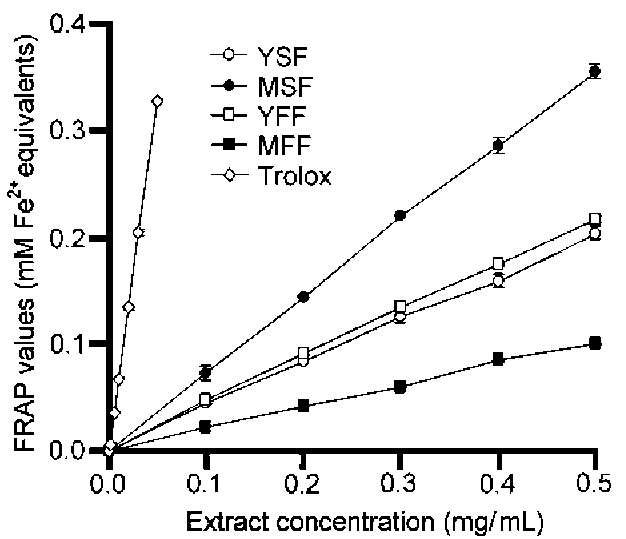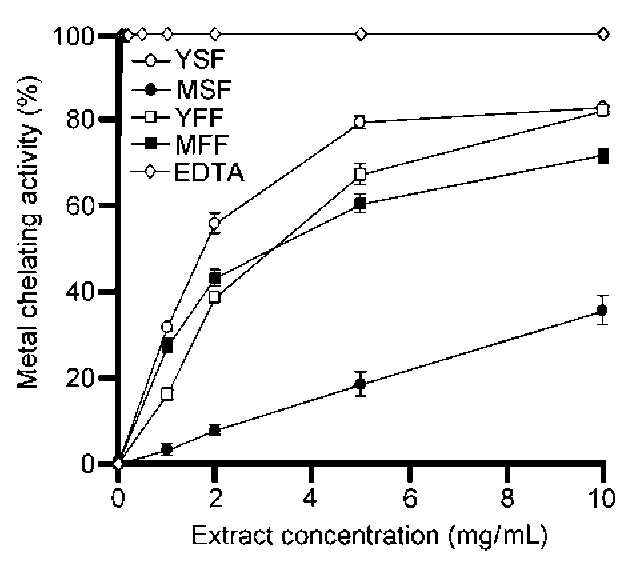442
Botanical Studies, Vol. 53, 2012


Figure 1.
DPPH radical scavenging activities of the leaf ex-
Figure 2.
Ferric reducing activities of the leaf extracts of S.
tracts of S. palustris, compared with Trolox. YSF, young sterile frond; MSF, mature sterile frond; YFF, young fertile frond; MFF, mature fertile frond. Data are mean 士 SE values (n=3).
palustris, compared with Trolox. YSF, young sterile frond; MSF, mature sterile frond; YFF, young fertile frond; MFF, mature fertile frond. Data are mean 士 SE values (n=3).
In our DPPH assay, the response curve for Trolox (positive control) levelled off close to but below 100% at 0.05 mg/mL and higher concentrations (Figure 1). The plateau in the response curve and our observation of complete loss of purple colour in the DPPH solution implied that complete scavenging of DPPH by Trolox had been achieved in our assay system. The inability to achieve 100% scavenging activity in a DPPH assay was also observed by others (Miliauskas et al., 2004; Barreira et al., 2009). These authors suggested that the residual yellow colour resulting from the decolorisation of a purple DPPH solution renders it impossible to obtain a "100% scavenging activity" when compared to the colourless methanol solution (blank)(Mil-iauskas et al., 2004; Barreira et al., 2009).
0.960, p<0.05). Thus, regardless of leaf type or developmental stage, variation in polyphenol contents accounted for at least 96% of the variation in the radical scavenging and ferric reducing activities among the leaf extracts. Antioxidant properties of hydroxycinnamic acids have been previously demonstrated (Silva et al., 2000; Gulcin, 2006; Maurya and Devasagayam, 2010). Hence, a higher hydroxycinnamic acid content may have contributed to the greater antioxidant activities of mature sterile frond when compared with young sterile frond. On the other hand, anthocyanins were likely the key flavonoid compounds responsible for the radical scavenging and ferric reducing activities detected in the extract of young sterile frond.
Besides being direct scavengers of free radicals, phenolic compounds may also prevent oxidative stress by acting as metal chelators, restricting metal-induced free radical formation (Dai and Mumper, 2010; Prochazkova et al., 2011). In this study, iron chelating activities of the four extracts increased in a concentration-dependent manner (Figure 3). At extract concentration 5 mg/mL, the anthocy-anin-rich young sterile frond had the highest iron chelating activity (79%), whereas mature sterile frond the lowest (18%). Our result implies that anthocyanins may have enhanced the metal chelating ability of the young sterile frond extract.
Ferric reducing abilities of all four extracts increased linearly over the concentration range tested (Figure 2). At extract concentration 0.5 mg/mL, FRAP value of young sterile frond was similar to that of young fertile frond, but was 2-fold higher compared with mature fertile frond. FRAP values of the extracts, expressed on a dry matter basis, were 72.36 士 0.52 (mature sterile frond), 45.07 士 0.74 (young fertile frond), 41.92 士 0.90 (young sterile frond), 20.99 士 0.45 mmol Fe2+/100 g dry matter (mature fertile frond), respectively. These values were all higher compared with 27 Chinese medicinal plants (Wong et al., 2006a).
A weak correlation was found between polyphenol content and metal chelating activity among the four extracts (R2 = 0.446, p<0.05). Such weak correlation between the two aforementioned parameters was previously reported (Hinneburg et al., 2006; Lim et al., 2009; Rumbaoa et al., 2009). Our observation implies that differences in the metal chelating activities among the extracts cannot be adequately explained by quantitative difference in their total polyphenol contents. Considering that the specific
The relative radical scavenging and ferric reducing activities of the extracts paralleled the relative abundance of total polyphenols, flavonoids, and hydroxycinnamic acids, suggesting that these activities were attributable to phenolic contents. Correlation analyses revealed strong, positive relationships between total polyphenol content and radical scavenging activity (R2 = 0.968, p<0.05) and between total polyphenol content and ferric reducing activity (R2 =
